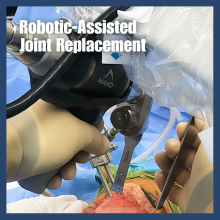What is a Deep Vein Thrombosis?
Deep vein thrombosis (DVT) occurs when a blood clot forms in one of the deep veins of the body. This can happen if a vein becomes damaged or if the blood flow within a vein slows down or stops. Two of the most common risk factors for the development of a DVT are an injury to your lower body and surgery that involves your hips or legs.
A DVT can have serious consequences. If a blood clot breaks free, it may travel through the bloodstream and block blood-flow to the lungs. Although rare, this complication (called a pulmonary embolism) can be fatal. Even if a blood clot does not break free, it may cause permanent damage to the valves in the vein. This damage can lead to long-term problems in the leg such as pain, swelling, and leg sores.
In many cases, DVT occurs without noticeable symptoms and can be very difficult to detect. For this reason, surgeons focus on preventing the development of DVT using different types of therapies, depending upon a patient's risk and needs. Your surgeon will take steps to prevent DVT if you have a major fracture or are having lower extremity surgery—including total hip or knee replacement surgery.
Pulmonary Embolism
As mentioned above, one serious complication of DVT development after surgery is pulmonary embolism - a blood clot that breaks free and travels through the veins. This can happen right after the formation of the blood clot or it may happen days later. If the blood clot reaches the lungs, it can block the flow of blood to the lungs and heart. A pulmonary embolism is a serious medical emergency and can lead to death.
Preventing Blood Clots After Orthopaedic Surgery
Deep vein thrombosis can develop after any major surgery. People who have surgery on the legs and hip are especially at risk. A pulmonary embolism is a blood clot that breaks-free and travels through the veins. If it reaches the lungs, it can block the flow of blood to the lungs and heart. A pulmonary embolism is a dangerous condition that can even lead to death.
Your surgeon will outline a program to help prevent the development of blood clots after surgery. The program may include periodic elevation of your legs, lower leg exercises to increase circulation, support stockings, and medication to thin your blood. This video provides additional information about DVT and its prevention.
It is important to work with your surgical care team prior to surgery to customize a prevention strategy best for each patient. If you have additional questions or concerns about the safety measures most important during hip and knee replacement, CONTACT our office today (615) 791-2630








